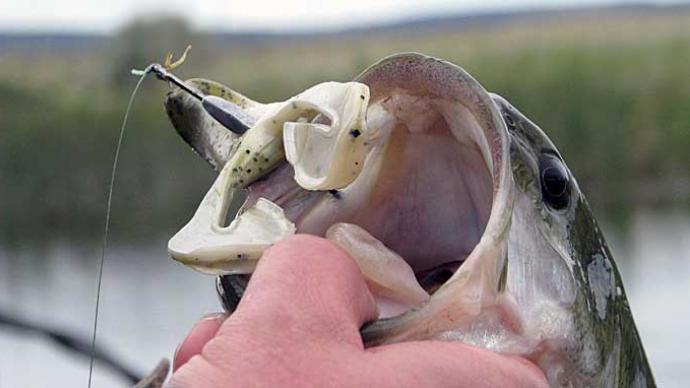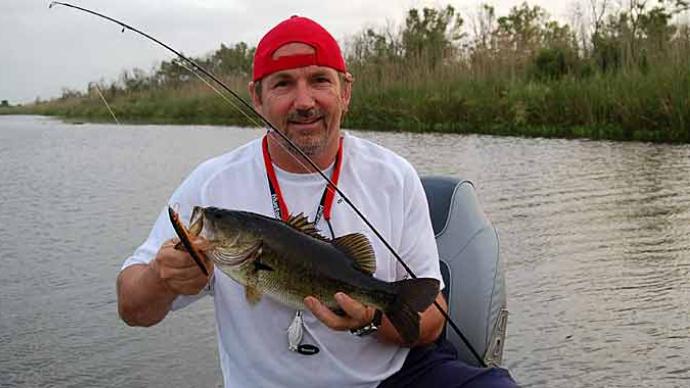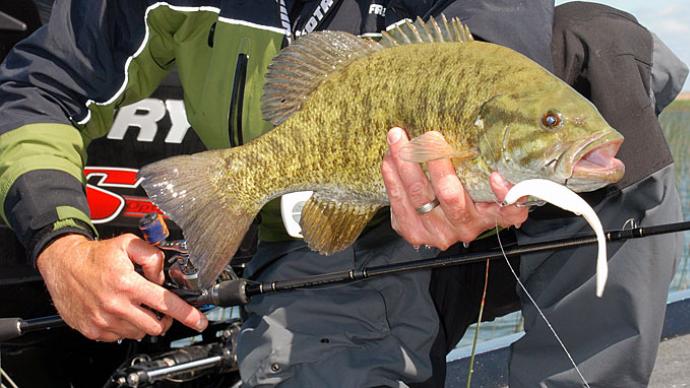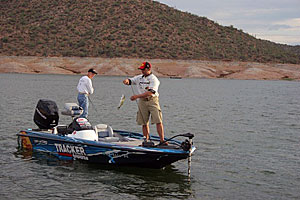
In the west, we have huge reservoirs that can be hundreds of feet deep. Giant bass may spend most of their time on structure found at depths of up to 50 feet. Paul Duclos, a California angler who has caught well over 100 fish weighing more than 10 pounds, fishes deeper water with various lures on his favorite California lakes. I know you’ll remember Paul – he’s the guy who caught a potential world record bass – 24 pounds – weighed it on a bathroom scale, and released it.
Don’t get me wrong - not all big fish are caught deep, nor are big bass caught on large baits. The Texas ShareLunker program shows fish that are caught on crankbaits, as well as lunkers caught by guys who are crappie fishing. At a recent Toyota Big Bass Classic on Lake Fork held during May, anglers were catching big fish like crazy up shallow because the shad spawn was in progress and the bass were up capitalizing on that. However, even during the shad spawn, the shallow bite isn’t on all day long. Anglers also saw big balls of shad on the graph in deep water and targeting bass by fishing those areas with deep-diving crankbaits and other deep-water lures.
Learning how to fish deep water, especially locating great deep-water structure, will help you catch more and better bass. Duclos says that most of his big fish are caught 18 to 25 feet deep. “Big bass cruise up into shallower water to feed, but they like to stay close to their deep water,” he says. Your best chance to catch these fish is when they are looking for food. As a result, he concentrates on likely feeding areas very close to deep water and fishes them for hours, waiting for a big fish to come by and grab his lure. In winter, steeper structure like rip rap and bluffs can be productive.
Flat areas on points where two channels come together are ideal, as are humps that rise suddenly from deep water without breaking the surface. Such humps, if they are around twenty feet deep at the top, are seldom marked by buoys since they are not navigation hazards on most lakes. Areas like these are gold mines. A clump of submerged trees, a rock pile, or even a single stump near this type of structure could be the home of trophy bass. To find these honey holes, start with a good lake map.
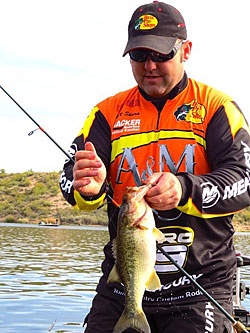
On a paper map, get some permanent markers with sharp points, and start marking the contour lines at intervals, using different colors for different depths. Coloring those contour lines will make humps and islands stick out like a sore thumb, so it’s worth the time. You may want to highlight things like old road beds and creek channels. In the old days, finding the submerged humps and underwater structure was problematic. One day we spent over an hour locating a hump by sighting between hills and then driving back and forth watching the depthfinder. A GPS unit is invaluable here. Once you do locate a killer spot, mark it. Then, the next time you are fishing, you can quickly locate it again.
Matt Shura, a tournament angler and Nitro pro in Arizona, uses a high-end Lowrance HDS10 and an HDS8. Both units run Navionics electronic charts. “These days, if you’re not running Navionics, you’re not cashing checks,” he says. These depth finders are fantastic – the huge screen can be programmed to show the map on one side and the depthfinder on the other. The maps are detailed contour maps, and your boat is shown as a triangle, so you always know exactly where you are. You can program it to mark where you’ve been, and with a touch of a button, it will remember a specific spot forever. These big Lowrance units include Insight Genesis, a free program that allows you to create customized maps from your survey data. The subscription upgrade lets you download maps on your plotter and overlay vegetation and bottom composition views. You can also access community data with the Social Mapping Layer. The units aren’t cheap – the HDS12 is over $3000, but according to Shura, they are worth the money.
To stay on these big fish spots, you’ll need marker buoys if you don’t have one of the mapping depth finders. Some people hate marker buoys because they think everyone is watching them and will steal "their" spot, but if you're out there for more than a few minutes, anyone who sees you will know you are fishing anyway. Marker buoys reduce the time you waste trying to stay on your hump. Toss one out on the high point, then go all around and over the area, watching your depthfinder to get the lay of the land. The fish may use the steep side once, a slight dip next, etc. Every time you pull up on your hump, you want to check it out all over, looking for fish on the depthfinder and fishing it thoroughly.
Shura knows that a good spot is a good spot. He will stay there and fish for hours if he has faith in a spot. One of the things he looks for is a breakline off a flat. Bass will cruise up on the flats to chase shad, then drop down to deeper water. In the summer especially, deeper water is a comfort zone for big fish. A nice creek channel running up to a point or shallow water will also get Matt’s attention. At Saguaro, his Lowrance helped him locate a “magic tree” on the edge of a flat where the bottom dropped off from 15 feet to 30 feet. “You can sit here for hours and not get a bite,” Matt says, “then suddenly you’ll get a double hook up.” He’ll sit just a cast away from that tree and fish it with whatever the conditions call.
The key is versatility, Matt says. Carolina rig, drop shot, spoon, jig – whatever it takes, that’s what he throws. The warmer the water, the faster the bait. You can see everything when you have one of these big Lowrance depthfinders. He keeps an eye on the screen and watches for schools of baitfish or a great piece of structure. “Stuff shows up on these graphs like a video game,” he says. “Guys will ask you how you caught them, and you just say ‘video game,’ and they know exactly what you mean!”
A drop shot or a spoon is the perfect bait when the fish are right under his boat. Even if the fish are suspended, he can see his lure on the screen, so he knows when he has it in the right place. Matt started using side imaging about a year ago. Even though he’d been fishing at Saguaro Lake for 25 years, he says he can’t believe how much he didn’t know about that lake. The side scan can show you canyons and even branches on trees. Having big units with all the features is expensive, but Shura says you're at a disadvantage if you don’t have them.
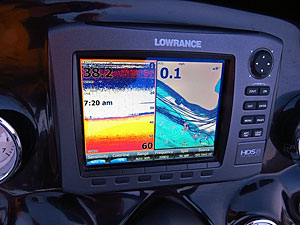
A Zoom Speed Craw is one of his favorite baits with a drop shot. One of his favorite combos is a 12- to 16-inch leader and a #1 Rebarb hook with a ¼-ounce weight. He’ll spray soft baits with Bang, especially when the bite is tough, and he re-sprays every few casts. Since he does a lot of seminars at the Mesa Bass Pro Shops store, he has plenty of opportunity to see how baits work in the tank. This combo, or the same one but with a Roboworm, has incredible action when fished with a bit of slack in the line.
“People hardly ever give their drop shot slack,” Shura says, “but it makes a huge difference – the action is amazing.” He slowly picks it up and sets the hook if it feels heavy. You have to believe they are down there, he says. Let your line have a little slack and pick it up now and then. He’s been catching 30-pound limits in the summer, doing that with drop shots and jigs and craws.
Old-timers used to spend years finding these honey holes, then have to use triangulation techniques with landmarks on the shore to get back on the spots, but nowadays, anybody who takes a day to learn to use electronics can kick butt on structure, Matt says.
He can use a side scan to locate a tree in a creek channel, then get back on it and fish it in seconds. He uses the zoom feature frequently. “If I’m fishing 50 feet deep, I could care less what’s in 10,” he explains. The zoom lets you see fish hugging the bottom, and with the advanced noise rejection and other features, the stuff you can see is just incredible.
When you are fishing deep and slow, the little things count. In deeper water, you’ve got a lot of line out and more opportunity for mistakes. Scent, sharp hooks, having your worm hanging straight, and checking your knots can mean the difference between getting that hawg in the boat or breaking it off. They can mean cashing a big tournament check or not getting a check at all.
If you’re happy just banging the banks, you can make do with any old graph. But if you’re serious about fishing deep water, you should start saving up for one of the big boys.


